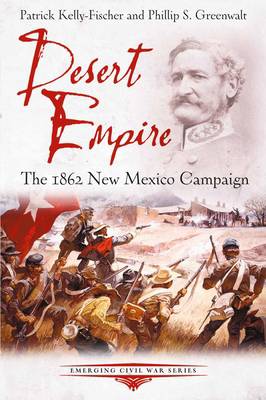
- Retrait en 2 heures
- Assortiment impressionnant
- Paiement sécurisé
- Toujours un magasin près de chez vous
- Retrait gratuit dans votre magasin Club
- 7.000.0000 titres dans notre catalogue
- Payer en toute sécurité
- Toujours un magasin près de chez vous
23,95 €
+ 47 points
Description
In late July of 1861, Lieutenant Colonel John Baylor and 258 Texas cavalry thundered into the small village of Mesilla, tucked along the Rio Grande River in the New Mexico Territory. They skirmished with U.S. regulars seeking to retake the town, and quickly forced them to retreat. It was a small victory that fueled visions of something much, much larger.
These Texans were the vanguard of the newly-formed Confederacy, seeking to fulfill long-held Southern dreams of expanding their influence westward to the gold fields of the Rocky Mountains and the Pacific Ocean ports of Southern California: a Confederate version of Manifest Destiny from "sea to shining sea."
The fighting at Mesilla was the opening act of one of the least-studied campaigns of the Civil War. For the next year, troops from Texas, New Mexico, Colorado, Arizona, and California would fight for control of the Southwest, its gold fields, and a route to the Pacific for the Confederacy. They marched across thousands of miles of scorching desert and over towering mountain passes, struggling with each other, hostile tribes, and the brutal elements, with the fate of the region hanging in the balance.
Emerging Civil War historians Patrick Kelly-Fischer and Phillip Greenwalt, longtime students of the Civil War, have spent countless hours researching and studying this too-long forgotten New Mexico Campaign of 1862. In Desert Empire: The 1862 New Mexico Campaign, they explore the battles that shaped the course of the war in the Southwest, and shaped the future of the region.
These Texans were the vanguard of the newly-formed Confederacy, seeking to fulfill long-held Southern dreams of expanding their influence westward to the gold fields of the Rocky Mountains and the Pacific Ocean ports of Southern California: a Confederate version of Manifest Destiny from "sea to shining sea."
The fighting at Mesilla was the opening act of one of the least-studied campaigns of the Civil War. For the next year, troops from Texas, New Mexico, Colorado, Arizona, and California would fight for control of the Southwest, its gold fields, and a route to the Pacific for the Confederacy. They marched across thousands of miles of scorching desert and over towering mountain passes, struggling with each other, hostile tribes, and the brutal elements, with the fate of the region hanging in the balance.
Emerging Civil War historians Patrick Kelly-Fischer and Phillip Greenwalt, longtime students of the Civil War, have spent countless hours researching and studying this too-long forgotten New Mexico Campaign of 1862. In Desert Empire: The 1862 New Mexico Campaign, they explore the battles that shaped the course of the war in the Southwest, and shaped the future of the region.
Spécifications
Parties prenantes
- Auteur(s) :
- Editeur:
Contenu
- Nombre de pages :
- 192
- Langue:
- Anglais
- Collection :
Caractéristiques
- EAN:
- 9781611217759
- Date de parution :
- 15-03-26
- Format:
- Livre broché
- Format numérique:
- Trade paperback (VS)
- Dimensions :
- 152 mm x 229 mm

Seulement chez Librairie Club
+ 47 points sur votre carte client de Librairie Club
Les avis
Nous publions uniquement les avis qui respectent les conditions requises. Consultez nos conditions pour les avis.








